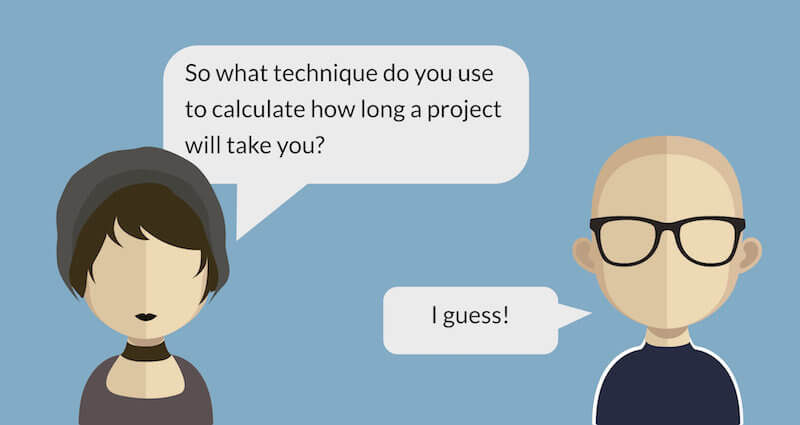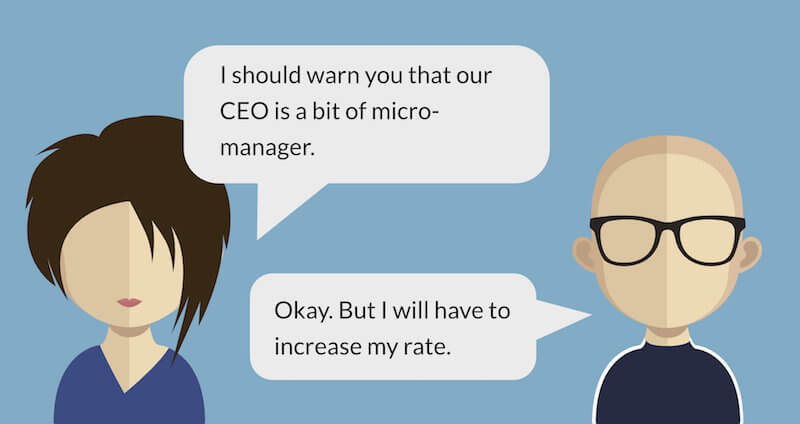How To Work Out What To Charge Clients: The Honest Version
Have you ever read a post that has left you feeling wholly inadequate because you know you can’t live up to the high standards they layout? Well, that is how I feel when I read posts about how much to charge my clients.
When Smashing Magazine asked me to write an article sharing my thoughts on pricing my services, I agreed without much thought. But now I sit down to write it, and I’m faced with a conundrum. Do I write about how you should price projects or do I tell you the truth about the unorthodox approach I take?
Convincing Clients: How To Get Sign Off When It Matters
That dreaded moment when after weeks of work we have to present to key stakeholders, and they mercilessly tear it apart. It feels inevitable, but usually, we can avoid these situations by planning ahead. Read a related article →
I have read many posts about the pricing of a project. From value-based pricing, to billing around Agile cycles. These are all great approaches I aspire to, but have somehow never managed to implement. I suspect I am not alone.
So instead of intimidating you with complex value-based pricing formulas or boring you to death with project Gantt charts, I am going to share with you the rather inelegant approach I take to the subject. Inelegant it may be, but it has allowed me to run a lucrative business for the last 15 years.
It begins by knowing the minimum you have to charge per hour.
Working With Difficult Clients
Unfortunately, there are clients who do not quite respect the work that you do, but there are a number of ways you can deal with them. Read a related article →
Calculate Your Minimum Rate
Okay, so this is the one bit of the process I have made an effort to approach professionally. It is important to know the minimum you have to charge per day to live. That isn’t going to be the rate I charge my clients. It is just the rate I am not willing to go below.

So how do we calculate that rate? Fortunately, it isn’t rocket science. Just follow these steps:
1. Establish A Minimum Salary
Start with the minimum wage you would like to take out of the business. How much do you want to earn a year? Remember, this is the minimum figure you could survive on. We will increase that number later.
2. Add Costs
Next, calculate your costs including reoccurring costs such as software services, rent, etc. But also include a budget for one-off costs such as that shiny new Mac you want. Work out how much this all comes to a year.
3. Remember To Save
Don't forget to plan for the future. Set aside some money each month for pension and savings. Calculate the total over a year and add it to your costs and salary.
4. Don’t Ignore Your Tax!
The figure you now have tells you how much money you must earn before tax. Now, add to that total the tax you would have to pay on that revenue. That will give you the minimum figure you need to earn over the year.
5. Calculate The Number Of Working Days
Before we can work out how much to charge per day, we first need to know how many days a year you work. To do that you follow these steps:
- Subtract weekends which immediately brings you down to 260 working days per year.
- Take off public holidays from your yearly total.
- Don't forget you will need some vacation time.
So in my case, it is 260 working days minus ten public holidays and 20 days vacation time.

6. Be Realistic About Your Chargeable Time
Unfortunately, we still cannot take our target revenue and divided by 230 days. That is because you will not be able to charge out every hour you work.
There are many other factors to consider. You will spend time marketing, writing proposals, doing admin, and managing your finances. None of these is chargeable. Realistically you can't expect to charge yourself out more than about 60% of the time.
All of this work will leave you with a minimum daily rate. Now we need to calculate how long our project will take. That is where you will begin to see my rather ad-hoc approach.
Take A Guess At How Long It Will Take
Sam Barnes wrote a brilliant post on calculating the time a project will take, as did Peter Mouland. I recommend you read these because, to be honest with you, I just guess.

Sure, if it is a big project I break it down a bit and try to price each part separately. But mainly it is a gut feel for how long things will take. I guess I have the advantage of doing this job for over 20 years, so the chances are I have done a similar project before. But I don’t want to lie to you and pretend I have some clever system. I don’t.
I found that for me, spending hours calculating how long things would take wasn't worth it. Whether I was bad at it or whether I am just unlucky, but there always seemed to be a curve ball that ended up making my carefully crafted figure inaccurate. I appear to do just as well taking an educated guess.
I make my best guess and times it by my minimum rate per day, and that gives me my minimum price. But this is not what I charge. In fact, if a client can only pay my minimum price then I walk away in most cases. After all, my calculation for the length of the project isn't exactly accurate, so I need to ensure I have a markup.
Markup Your Minimum Price
My minimum price tells me if the project is viable, but it isn’t an amount the client will ever see. I decide on that pricing using three very professional (sarcasm) factors that I outline below.
Factor In The “Can I Be Bothered” Equation
You know what it is like, some projects get you excited and some you couldn’t care less if you do. So why not factor that into your pricing? Projects that sound awesome and you desperately want to win, will hardly be marked up at all. Projects that look as dull as ditchwater gets a hefty wedge added on top of the minimum rate.

That makes a lot of sense if you think about it. It encourages more of the kind of work you want to be known for and that you love. It might seem unfair, but if the client doesn’t want to pay your premium to do a tedious project, he can always go elsewhere.
Remember “The Client Is An Ass” Tax
Next up we have "the client is an ass" tax. Always, always, take every opportunity you can to speak to the client before pricing their project. Ask lots of questions and get them talking. Do your best to ascertain what kind of client they are likely to be.
If you think they are going to be difficult to work with, charge them more. Again this makes sense. Demanding clients require you to put in more effort to deliver and so should be charged a premium for that extra effort.

Add The “What Can I Get Away With” Markup
Finally, we come to the most interesting one - what can I get away with charging? I work with a huge range of clients. Some are multinational conglomerates, and others are small charities or public sector organizations.
In theory, you could argue that I should charge all of those clients the same, but I don't. The multinational will pay more because they have more. I never got on with value based pricing, but I do recognize I have value and that my value is proportional to the organization. The larger the organization, the more they can do with the value I bring and so the more I am going to charge them for it.

There is a related factor here too. People often equate value with how much they pay. Therefore the more I charge them, the more they value what I produce. They take me more seriously if they are paying top dollar for me.
But what people perceive as expensive varies based on their situation. My charge out rate would seem cheap to a large multinational and costly to that smaller charity. Hence, I change my rates depending on the client.
It is important to note that none of the factors I use to decide on a price reflects how desperate I am for work. I don't charge less if I need the work and neither do I charge more if I am busy. That just feels like a slippery slope to me and stinks of desperation.
If times are tough, I would prefer to put my energies into sales and marketing rather than working on a project that I might not even break even on.
Am I Unprofessional?
I am conscious that this post may reflect poorly on me. I nearly didn't write it for fear it would seem unprofessional. But I know I am not alone in taking this kind of approach. We just don't talk about it.
In truth pricing projects is almost impossible to do accurately or in an entirely ‘fair' way. There are just too many variables, too many things that can go wrong. All we can do is take our best guess.
Also at the end of the day, pricing is about supply and demand. Pricing isn't a matter of calculating a rate based on hours spent or return generated. It's your time, and if people are willing to pay, you can charge whatever you like.
Further Reading
- Creating And Maintaining A Voice Of Customer Program
- Crafting A Killer Brand Identity For A Digital Product
- Why Content Is Such A Fundamental Part Of The Web Design Process
- How To Get Web Design Clients Fast (Part 1)


 Start with a free demo —
Start with a free demo —

 Check the frontend report!
Check the frontend report! Click here to kickstart your project for free in a matter of minutes.
Click here to kickstart your project for free in a matter of minutes. Take a break with a 3D game built on Netlify!
Take a break with a 3D game built on Netlify!


